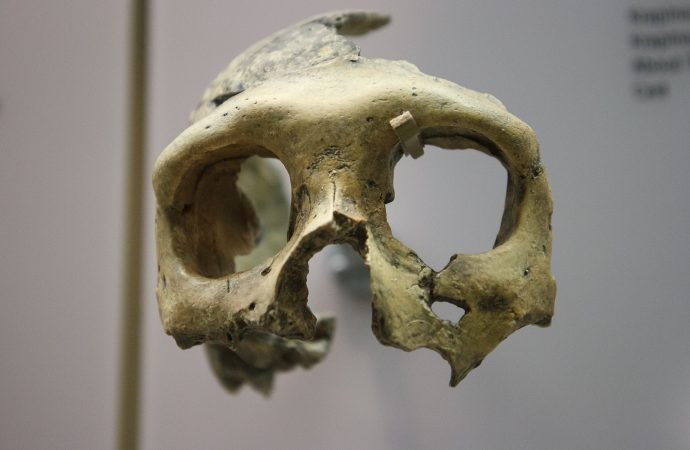Ever since “Lucy” was unearthed in the Olduvai Gorge in the 1960’s, the evolutionary “gap” that has existed between us, humans, and our closest genetic relatives, the chimpanzees, has ever so steadily been filling in with fossil specimens.
A number of them are listed below:
Graecopithecus freybergi

Credits: Fuss, J. et al (2017)
A new find by Professor Bohme and co-authors is the oldest hominin fossil to date, predating the oldest hominin specimen, at 6-7 million years of age, prior to this discovery by at least 100,000 years. Given this fact, it is quite surprising indeed to know that the jaw and molar specimens representative of this new species were found in Pyrgos, Greece, and Azmaka, Bulgaria, respectively. In other words, not from Africa – this appears to throw a monkey-wrench into the “classical” evolutionary theories of human origins.
Surely more analyses are required, but should these findings hold true then it suggests a more Mediterranean origin for the hominin line than an African one.
Reference: Böhme, Madelaine, et al. “Messinian age and savannah environment of the possible hominin Graecopithecus from Europe.” PLoS One 12.5 (2017): doi: 10.1371/journal.pone.0177347
Sahelanthropus tchadensis

Credit: TheCarlagas
The S. tchadensis was the then-oldest hominin fossil that recently was surpassed by Graecopithecus, above. Its skull exhibits a trait more akin to humans than to any other primate: the opening accommodating the spinal cord in this skull is located more at its base than at the back, implying Sahelanthropus walked, more-or-less, upright on two legs.
As implied in its name, this fossil was first unearthed in Chad. Nine crania have since been discovered, also located in the same area.
Reference: Denys, Christiane, et al. “A new hominid from the Upper Miocene of Chad, Central Africa.” Nature: International weekly journal of science 418.6899 (2002): 801.
Ardipithecus ramidus

Up until more recent finds were unearthed, Ardipithecus was the most antique species discovered near the Olduvai Gorge region of Africa surpassing the three-million-year-old Australopithecines-proper by at least a million years.
Like Sahelanthropus, the location of Ardipithecus’ spinal cord opening is nearer to the skull’s base.
Reference: Kimbel, William H., et al. “Ardipithecus ramidus and the evolution of the human cranial base.” Proceedings of the National Academy of Sciences 111.3 (2014): 948-953. doi: 10.1073/pnas.1322639111
Homo floresiensis

Credit: Cicero Moraes et al
This diminutive 1.5-2 million-year-old species hailing from the tiny island of Flores in Indonesia was one of the oldest hominin species not to be uncovered in Africa, at the time of its discovery.
Theories as to the “Hobbit’s” origins have long been debated, but newer research suggests that the Hobbit may be more closely related to Homo habilis than to Homo erectus sharing a common ancestor with the former rather than the latter. This would imply H. erectus was not the first species to migrate out of Africa.
Reference: Argue, Debbie, et al. “The affinities of Homo floresiensis based on phylogenetic analyses of cranial, dental, and postcranial characters.” Journal of Human Evolution (2017). doi: 10.1016/j.jhevol.2017.02.006
The Denisovans

Credit: John D. Croft
With only a toe-bone or two to their name, the Denisovan peoples were the Asiatic contemporaries to the Neanderthals. New genetic research has since essentially confirmed interbreeding between these two peoples and human beings in the distant past. This implies all three beings are the same species.
According to recent results attained by Dr. Reich and team, Oceanic peoples tend to possess more Denisovan genetic material than Neanderthal while “Western Eurasians,” interestingly, possess the least amount of material from either pre-human.
Reference: Gupta, Deepak, Sivanoli Ambalavanan, and Pandu Ranga Rao Bangaru. “Connecting The Dots in Theoretical Anthropology: Was This One of The Earliest Contemplation About Homo sapiens sapiens’ Fight for Survival and Interactions with Homo sapiens neanderthalensis and Homo sapiens denisova?.” (2016). doi: 10.1016/j.cub.2016.03.037
Homo naledi

Credit: Lee Roger Berger research team
This is another new fossil find, this time made possible by crowd-funding! A large collection of skeletons from this hominid were uncovered by a team led by Lee Berger inside the Rising Star cave system located in South Africa. Berger and team hypothesize that, since only H. naledi specimens are found in this cave, and the number of skeletons is large, Rising Star may be a burial site.
H. naledi appears to have a rather primitive posture, yet possesses surprisingly “modern” hands and jaws; where this species fits in with respect to the other hominins and hominids is undetermined. The cave site has been dated to around 300,000 years.
Reference: Berger, Lee R., et al. “Homo naledi, a new species of the genus Homo from the Dinaledi Chamber, South Africa.” Elife 4 (2015): e09560.
Image Credit: Adam Foster / National Museum of Natural History





